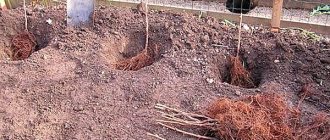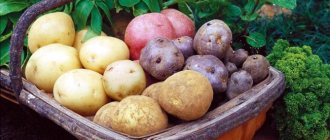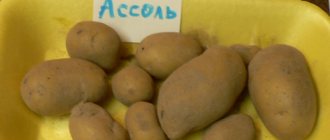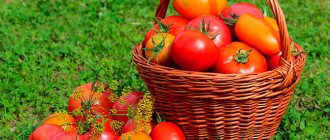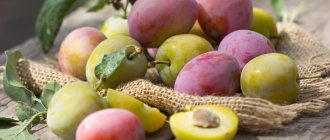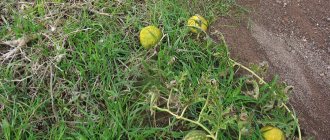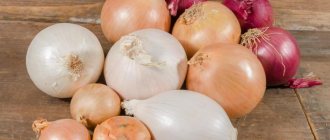655
When stocking up on vegetables for the winter, the first thing a person thinks about is purchasing a sufficient amount of potatoes. This is what you can eat every day and in such a way that dishes prepared from it will not be repeated for a long time. It’s not for nothing that potatoes are also called the second bread - you can make pancakes from them, and all kinds of flatbreads.
Fortunately, on the Internet today there are many recipes from folk craftsmen. That’s why people stock up on potatoes for the long winter months until the next first harvest. But not every experienced gardener knows how to choose the right potatoes for the winter on the market. It is necessary to take into account some nuances.
Which one is best to store?
Potatoes for the winter need to be purchased from several varieties at once - and there will be a variety of taste and technical qualities, and the likelihood that at least one of them will last until spring increases. The market often offers pink or white potatoes. So, if the question arises which one is better to choose, you need to know that the second one, with a light skin, is the most shelf-stable.
You should not take early varieties for storage - they deteriorate much faster than late ones. When choosing, you should pay attention to dry and clean root vegetables. This appearance indicates that the potatoes were not harvested during the rains. But wet, with pieces of soil, indicates the opposite - the potatoes are saturated with moisture and will not lie for a long time.
You should not buy a lot of bags for winter storage at once. Potatoes may not be to your liking in terms of taste or internal content. It often happens that a beautiful peel hides rot or other defects.
Therefore, for starters, it’s worth buying a couple of kilograms for testing, looking at the core or just smelling it. Potatoes that are loaded with chemicals or contaminated will smell bad on the inside.
Six categories of seed potatoes
Seed potato tubers are divided into several categories: super-super-elite, super-elite, elite, tubers of the first, second and third reproduction. Super-super-elite and super-elite are the “cleanest” potatoes, completely free from any infections, grown in laboratory conditions from the meristem. This is a very expensive planting material, which is usually purchased by nurseries for the subsequent production of elite seed potatoes and first reproduction potatoes.
Elite seed potatoes are high-quality planting material that is not contaminated with viruses and bacteria. It will grow into completely healthy plants, most responsive to good care and producing a high yield of high-quality tubers.
First reproduction potatoes are seed potatoes obtained in the first year after planting elite tubers. Such planting material also gives a good harvest, but it begins to accumulate diseases faster than elite class potatoes.
Potatoes of the second and third reproduction also produce a good harvest, but very quickly “fade out” and literally after a year or two goes into the category of “food potatoes”, whose yield drops significantly, varietal characteristics and resistance to diseases are lost.
Most often you can find “elite” and first reproduction potatoes on sale - this is a fairly high-quality planting material at a price quite acceptable for summer residents.
Choice by appearance
You can also choose potatoes for storage in a store, but most purchases take place at agricultural markets, where the assortment is usually much richer. And first of all, of course, the appearance of the proposed product catches the eye. As has already been established, large potatoes are sold much more expensive than small ones. The first one is easy to clean, and the second one can be bought by those who have a rather acute financial issue.
But nutritionists are still arguing about which of them is the most useful. Some argue that medium and small potatoes contain fewer nitrates and more nutrients, while large ones contain a lot of chemicals. The latter advise choosing large tubers, since they are fully ripe and have acquired a sufficient amount of vitamins.
But whatever your choice, you should not buy potatoes with peeling skin. This is a sign of immaturity, and therefore short storage. Ripe potatoes have smooth, thick skin, without signs of peeling.
If the question is about which potatoes are best to buy for the winter, then you should choose the one that grew in sandy soil. Starchy, aromatic and crumbly, it will be a welcome guest on every table. But potatoes grown on peat bogs are worse in taste and keeping quality.
How to buy good seed potatoes?
Markets usually sell potatoes for planting in bags or nets. In order to sell more goods, sellers are cunning, hiding bad tubers deep in the net, and putting good ones on public display. So the netted potatoes appear healthy, but are actually half bad. Bad weather also plays into sellers' hands. When potatoes are purchased for planting, it is still cold outside. It is not possible to “wander” around the market for a long time or look at potatoes in nets, so buyers agree to what the seller offers, and at home they begin to regret their choice.
Markets usually sell potatoes for planting in bags or nets
That is why, if you decide to buy seed potatoes rather than grow them yourself, you need to contact specialized stores or farms and nurseries that have product quality licenses. Only in this case can we hope that the quality of the tubers will be good.
You can also purchase seed potatoes from good friends and trusted suppliers who will definitely not deceive you with the seed material.
Which variety to choose for storage
The question of which type of potato is best stored in winter worries many thrifty owners today. But not all of them know that the entire multi-thousand varietal variety is divided into 4 groups by an international classifier according to the degree of density.
Mostly varieties of the last, fourth group are sold on domestic markets. Below is a list that briefly outlines which potato varieties are best stored for the longest time in winter:
- Belaya Rossa;
- Arrow;
- Minerva;
- Tiras;
- Red-chamb;
- Kamensky.
How to select seed tubers?
Most gardeners who have been growing potatoes for many years prepare their own seed. To do this, when growing potatoes, only the bushes that are richest in harvest during the autumn ripening period are selected. During flowering they are marked and dug up approximately 1.5-2 weeks after final ripening. Seed potatoes should always be stored separately from the main crop!
Article on the topic: Potato planting rate per 1 hectare and hundred square meters (in pcs. and kg)
You need to select potatoes for sowing very carefully. Not all tubers are suitable for further planting; they must have different characteristics:
You need to select medium-sized potatoes (about the size of a chicken egg or a little larger)
- normal, medium size (about the size of a chicken egg or a little larger), the diameter should be 45-55 cm, and the weight should be 40-80 g;
- absence of ugliness, the shape must be typical for the variety;
- there should be no illnesses or injuries;
- Slightly sprouted tubers are also suitable.
Seed potatoes for sale are selected according to the same principles, only it is better to take larger sizes. The weight of such tubers should be in the range of 100-130 g.
Seed potatoes are stored separately, at the same temperatures as the simple crop, until about mid-January, and then preparation for planting begins.
Selection by external data
How to choose the right potatoes to store for the winter? You should first look at the visual characteristics:
- Size is a purely individual criterion.
- Density – tubers should not crack or split when cut.
- There should be no dark circles near the eyes - signs of rotting from the inside.
- You should not take washed potatoes - the process of storing them will tell you much better about the qualities of unwashed root vegetables.
- Outer shell - by the potato skin, dense and smooth, you can immediately understand that the tuber will be stored for a long time.
- Absence of green spots - if there are any, then the potato is infected. Small holes and grooves may indicate the disease. They are made by insects. To check your suspicions, cut the potatoes and see if there are holes inside them.
How to select and prepare seed potatoes for planting
To reap a large potato harvest, only the best seed material is selected for planting. In this case, you can hope for good results. The problem is that good seed potatoes do not always produce large yields if they are not properly prepared for planting. The article will describe how to choose or buy seed potatoes and what preparatory work needs to be done before planting them.
Testing for nitrates
Once the characteristics of good potatoes are listed, the question arises as to whether the potatoes you buy contain nitrates. Almost all manufacturers use fertilizers: some are nitrogen, others are mineral. And it’s quite easy to determine whether they are present in potatoes.
The tuber should be picked with a fingernail; if it easily penetrates the pulp, it means there are plenty of nitrates in it. You can simply cut the potatoes - oozing moisture will indicate an excess of fertilizers. The tuber must be hard and elastic; natural potatoes are stored for a long time. Before purchasing, you should ask in what area the product was grown.
The most scrupulous customers can be helped by a special device that determines the percentage of nitrate content.
Sprouting potatoes
The last stage of preparation for planting is germination. You can germinate using different methods; each has its positive qualities and disadvantages.
- Germination in the light. Potatoes are laid out in 1-2 layers in boxes or directly on the floor. The temperature in a well-lit room should be +12…+16 degrees. This germination lasts 30-40 days. The main difficulty is that direct rays of light should not fall on the tubers. And the advantages are that such germination always reveals damaged and diseased tubers and increases yield by 35-40%.
- Germination by heating. If seed potatoes do not germinate, you can encourage them to do so. To begin with, in a bright room with a temperature of +16 degrees, potatoes are laid out directly on the floor for about 2 weeks. During this time it will sprout. Then it is collected and 3-4 days before planting it is heated in a room at a temperature of +30...+35 degrees. This stimulates the production of all the necessary substances for normal growth in the ground.
Germination in the light
Are there nitrate-free potatoes on the market?
Probably every grower dreams of growing potatoes that do not spoil and are not eaten by the Colorado potato beetle. And at the same time, I want not to use chemicals in the growing process.
But, as harsh reality shows, growing organic potatoes without the use of chemicals is very problematic. The cost of such products will be sky-high.
Therefore, those who position their product on the market as natural are being a little cunning. They simply replace all mineral fertilizers with organic matter. With this feeding, the tubers have a pleasant taste, are stored for a long time and are in demand among buyers.
You should inquire about the conditions under which the potatoes were stored before sale. Of course, not all sellers will answer this honestly. But those who sell their own products will tell you everything in detail.
You should choose the right potatoes for the winter by observing all of the above evaluation criteria and listening to the recommendations of those who are well versed in all the intricacies of purchasing goods on the market, as well as based on your own taste preferences and how the potatoes will be used. The latter is important when purchasing, because many varieties have been bred specifically for frying and cooking.
Those who do not understand all the varietal intricacies in detail should choose universal varieties if the question arises of how to choose potatoes for storage for the winter. And proper storage of purchased tubers will allow you to enjoy potato dishes until the next harvest.
How to select, save and plant seed potatoes for high yields
Adding an article to a new collection
Potatoes are a crop that is one of the most vulnerable to various diseases. Penetrating through the leaves, viral, fungal and bacterial infections accumulate in the tubers over time and thereby provoke potato degeneration.
The favorite potato variety has ceased to provide good harvests and has become easily susceptible to disease. All the efforts spent on growing potatoes cease to pay off - the yield is inexorably declining, and the quality of the grown tubers leaves much to be desired... If you are also familiar with this situation, take immediate action!
Related article: Folk remedies for the Colorado potato beetle - full review
The most correct decision is to update the planting material. You can do this in two ways:
- grow your own potatoes from seeds;
- purchase elite seed potatoes obtained from healthy plants.
The first method is suitable for those who like to experiment and are willing to spend several years growing their own healthy potatoes. The second method is optimal for those who are not ready to waste precious time and want to grow a good harvest of tasty potatoes this season.
Main rules and recommendations when choosing a variety for planting
When choosing a vegetable variety to plant, you should pay attention to various criteria. These include the following:
- Freshness of planting material . Varieties of root crops tend to degenerate, so none of them maintain high yields for many years. Usually varieties degenerate within 10-15 years.
- Geographical location . When choosing the type of potato to plant, you need to consider the geographic region. Thus, some varieties give good yields in the southern part of Russia, but grow poorly in the middle zone and northern part; others, on the contrary, tolerate low temperatures and are completely unadapted to hot climate conditions.
- Susceptibility to pest attacks and diseases characteristic of nightshade crops. A certain area is characterized by its own pests and diseases that affect nightshade crops. That is why, when choosing a variety, you need to choose one that is characterized by resistance to certain parasites and diseases.
- Origin . Now not only domestic, but also foreign varieties of potatoes are planted. Some people do not accept the taste of unusual foreign types of potatoes, so this factor also needs to be taken into account.
The taste of the vegetable and its digestibility are also important. Based on this criterion, the following types of varieties are distinguished:
- Type A. Potatoes do not boil soft. Tubers are suitable for first courses and salads.
- Type B. The tubers are poorly cooked and crack a little. This type of potato is used for soups and stir-fries, as well as for chips.
- Type C. Potatoes of this type are very overcooked. The tubers are used for boiling and deep-frying, and for puree.
- Type D. These varieties are only suitable for purees and casseroles.
Having decided on the optimal set of characteristics, you can select the desired potato variety from among their variety.
Optimal potato varieties for specific regions of Russia
In the process of determining the best variety of vegetable for planting, you need to take into account the characteristics of the region in which it will grow.
Northern region
For the northern region (Murmansk and Arkhangelsk regions, the Komi and Karelia republics) choosing a suitable potato variety is not easy, but possible. In harsh climates, the following varieties are capable of producing many tubers:
- Nevsky. This type of potato is mid-early. It is frost-resistant, keeps well, produces large vegetables. The usual weight of a tuber is 100 g. Ripening occurs in 80-90 days.
- Aurora. The variety is characterized by a medium degree of maturity. It gives good yield: about 350 centners of potatoes are harvested from one hectare. The weight of one tuber is from 95 to 130 g. Potatoes of the Aurora variety have excellent taste, have good keeping quality, and are resistant to most diseases that affect nightshades.
- Gloria. This is an early ripening variety. The tubers are medium in size, the weight of each varies between 80-130 g. Up to 415 centners of vegetables are harvested from one hectare. Gloria is resistant to nematodes and potato cancer.
Potato variety Nevsky
Potato variety Aurora
Potato variety Gloria
Central Russia
For planting within central Russia, that is, the Central European part of the country, where a temperate continental climate prevails and excess humidity is observed, the following varieties are best suited:
- Bellarosa. The tubers are ready for harvest in 50-60 days. The weight of one tuber is from 120 to 210 g. The plant is resistant to golden nematode and cancer, unpretentious to soil: it can be grown in any soil except clayey soil. Bellarosa tolerates drought and stores well.
- Favorite. This variety belongs to the mid-season varieties. Potatoes ripen in 70-90 days. The weight of one tuber is 90-125 g. This variety tolerates low spring temperatures well and produces a generous harvest. Shows resistance to late blight and various viruses.
- Zarnitsa. The specified potato variety is late-ripening. Tubers ripen in 120-140 days. The weight of one tuber will be 160 g. This variety is drought-resistant and unpretentious to the type of soil. Zarnitsa is resistant to nematodes, cancer, and scab.
Potato variety Bellarosa
Potato variety Lyubimets
Potato variety Zarnitsa
Moscow region
For the Moscow region, the optimal types of potatoes grown in open soil are early and mid-early varieties, since the climate of this territory does not provide for a long warm period.
For the Moscow region, you should choose one of the varieties below:
- Spring. This variety belongs to the group of early high-yielding ones. The tubers are well stored and are not susceptible to spot rot or late blight. Potatoes have a rich taste and can be used to prepare any dish.
- Vineta. An early-ripening potato variety that is drought-resistant. Tubers ripen in 75 days. From one bush you can collect 10-12 potatoes, each weighing 75-85 g.
- Luck. This is also an early ripening variety, ideal for the climatic conditions of the Moscow region. Potato tubers ripen in about 75 days. On average, one nest produces up to 15 potatoes. The vegetable has excellent taste, is stored well and for a long time, and is not demanding in care.
Spring potato variety
Potato variety Vineta
Potato variety Udacha
Ural
The Ural region is known for its harsh climate. A total of 30 potato varieties can grow in these areas, most of them early ripening. Late-ripening vegetables do not have time to ripen in harsh climatic conditions.
The following varieties are suitable for the Urals:
- Agnes. The ripening period is 81-87 days. The weight of each tuber is from 105 to 155 g. This variety is characterized by increased susceptibility to diseases that spoil the harvest.
- Lyubava. These are potatoes belonging to early ripening varieties. It resists many potato diseases, but is susceptible to nematodes and canker. Maturation periods are no more than 70 days. Tubers of the Lyubava variety are large - each of them reaches a weight of 130 to 200 g. They are stored for a long time and do not sprout.
- Nikulinsky. Potatoes are mid-season. Ripening period is 120-125 days. The weight of each tuber is from 80 to 125 g. The variety is characterized by regular yield and immunity to many diseases.
Potato variety Agnes
Potato variety Lyubava
Potato variety Nikulinsky
Siberia
Siberia, with its harsh climate, requires special varieties of potatoes to grow. Mostly early, mid-early and mid-season varieties are planted here.
Most often in Siberia, the Malamur variety of potatoes is grown, which is the best of the mid-early varieties. The harvest ripens in 77-87 days. Each tuber weighs 125-145 g. Potatoes of this variety are especially susceptible to the golden nematode.
Cold-tolerant potato varieties are listed in this article.
